This story was produced in partnership with Reporting Democracy, a cross-border journalism platform run by the Balkan Investigative Reporting Network.
Several hundred people gathered in the Slovak capital of Bratislava on Tuesday evening in solidarity with demonstrators in Serbia, after a photo exhibition in the Serbian multi-ethnic town of Bački Petrovac was violently disrupted earlier this month during the Slovak National Festivities.
The rally in Bratislava combined speeches, images from recent Serbian protests, and a public reading of a letter from the visual artist Olja Triaška Stefanović sent from her home in Bački Petrovac (Báčsky Petrovec in Slovak). Serbian by birth, she married into the Slovak community in Vojvodina and studied in Slovakia – an experience that, she said, gave her the perspective of living as part of a minority herself.
In her letter, Stefanović referenced a family photograph of her grandfather sitting alongside Hungarian, Slovak and German neighbours in the summer before World War II, all drinking spritzer – white wine mixed with sparkling water. “In a single shot I see the essence of Vojvodina,” she wrote. “There is no question of who is a minority and who is a majority – we are all neighbours.”
Vojvodina, Serbia’s multi-ethnic northern province, still recognises eight official languages, a pluralism Stefanović described as increasingly under siege. She accused Serbian President Aleksandar Vučić of presiding over a “criminal dictatorship” that for more than 15 years has weaponised questions of minority identity.
She recalled feeling like a minority twice over: in the 1990s, when she protested the Balkan wars, and again under Vučić, when acquaintances refused to sit with her “because I was not Serbian enough”.
Now, she wrote, living among her husband’s Slovak family in Vojvodina had brought her closer to her grandfather’s world, in which identity was rooted in neighbourly bonds rather than imposed divisions.
Violence around photography
Stefanović’s testimony was prompted by the disruption on August 9 of the Bački Petrovac exhibition, which showed photographs of recent Serbian protests taken by young activists and students in villages where Slovak minorities live, including Pivnice, Kovačica, Kulpin, Padina and Hložany as well as Bački Petrovac.
The display – announced to police in advance – coincided with the annual Slovak National Festivities, the cultural centrepiece for Vojvodina’s Slovak community, which numbers about 42,000, according to the 2022 census. That figure has steadily declined, a trend some blame on the rule of Vučić’s Serbian Progressive Party (SNS).
The exhibition was not part of the main program. Instead, photographs were strung on a line between three trees near the local library, a modest setting that organisers hoped would invite quiet reflection on the reality of life in Serbia.
Titled “Life in Slovak Communities You Won’t See in Hlas Ľudu” – a jab at the state-aligned Slovak-language weekly that has largely ignored the protest movement – the exhibition instead became a flashpoint for a violent political confrontation.
Organisers of the show – some of whom later attended the Bratislava gathering – said that on August 9, supporters and members of Vučić’s SNS, including municipal officials of both Slovak and Serbian background, twice tore down images and physically assaulted participants, among them Slovaks, Serbs and even war veterans. Police, they said, stood by and did not intervene.
Serbia’s opposition parties condemned the attacks. “The photographs contain no element of hatred – only solidarity and love,” said Sara Valentik, a Serbian Slovak who studied at a university in Slovakia’s Banská Bystrica and helped stage the exhibition. “This is not a problem between nationalities. It is a problem with the ruling party, which cannot tolerate independent thought.”
Despite intimidation, organisers re-mounted the show the following day. Supporters travelled from across Serbia to attend, some arriving by bicycle along back roads after police and local officials blocked main routes. Others, like Marija Srdić of the Civic Movement Bravo, came by small boats, determined to see the exhibition.
“It was a small sabotage team – but saboteurs who do not carry weapons, only strong will,” she said. “Our will is that small sabotage, and we will always act like that.”
The photo series, shown in both Bački Petrovac and Bratislava and scheduled to travel across Slovakia, documented a wave of student-led protests that has swelled since November 2024, when the collapse of a railway station canopy in Novi Sad killed 16 people. Students blocked universities, demanding accountability and prosecutions. When their demands were ignored, they called for early elections.
Clashes with pro-government groups have since become common. Women and children have also been detained. “Dozens of women, students and even children have been arrested. This is the reality we are living in,” said Stefanović, appealing to European institutions to investigate and halt these abuses and acts of violence.
Meanwhile, Juraj Bartoš, a former journalist, told the Bratislava crowd that dissidents had launched an alternative “free” edition of Hlas ľudu in March to cover the student-led demonstrations against corruption and what participants describe as creeping authoritarianism.
Culture as political battleground
Stefanović’s letter also criticised both Belgrade and Bratislava for allowing cultural institutions to be misused for political ends. She singled out the closure of Bratislava’s Kunsthalle gallery by the government of Robert Fico while it was showing an exhibition on the alleged endangerment of Serbian cultural heritage in Kosovo, which was being staged with little public notice in either country.
“It was a sign of support for Vučić’s regime – the same regime that sends thugs to beat people up for telling the truth,” she wrote in her letter.
Vučić and Fico enjoy warm relations. They met in Moscow in May, after which the Serbian president posted on social media: “Serbs and Slovaks, brothers forever!” In March, as protests swept Serbia, Fico voiced support for Vučić, declaring that in a “democratic country the street must not overturn the results of free elections.” Moreover, Fico has repeatedly vowed that Slovakia will never recognise Kosovo’s independence and voiced support for Serbia’s accession to the EU.
In Bratislava, the journalist Bartoš reminded the crowd that the recent attack was not the first of its kind. On May 31, during elections for the governing bodies of Matica slovenská – the main cultural institution of the Slovak minority in Serbia – a similar incident took place at the Slovak National Theatre in Bački Petrovac.
“Thugs blocked those who wanted to observe the vote from entering,” Bartoš said. “The Slovak ambassador [Michal Pavúk] entered and left through a side door. But he never came outside to see what was happening.” And outside, although it did not escalate into a full fight as at the exhibition, two or three women were struck, knocked to the ground, their phones smashed, according to Bartoš.
Anti-Slovak intimidation is not new in Vojvodina. Two years ago, in one village, a list of Slovaks marked for expulsion was posted on a church door. A year later, in Kisač (Kysáč in Slovak), the slogan “Kill the Slovak” was sprayed in ten different locations. The perpetrators were never identified.
Serbia’s Academic Plenum, an assembly of scholars, also drew attention to the Matica slovenská election incident after the attack in Bački Petrovac. The August 9 assault, it said, was “not accidental, but direct retaliation” for the government’s defeat in those elections. “As in Nazi Germany in the 1930s, persecution begins with attacks on cultural institutions and peaceful gatherings of minority communities, inciting fear and violence. Silence in such moments means complicity,” the statement declared, demanding resignations from senior officials responsible for minority affairs.
Serbia’s Ministry for Human and Minority Rights stayed silent. But the National Council of the Slovak National Minority – a 25-member elected body that approves school directors in Slovak areas, oversees the cultural institute and publishes the weekly Hlas ľudu – issued a statement condemning what it called “a direct attempt by blockaders and opposition parties to politicise the Slovak National Festivities.”
Juraj Červenák, president of Matica slovenská in Serbia, was among the few to speak out in defence of Slovaks in Vojvodina after the Bački Petrovac attack. Despite the tensions, he said in an interview, relations between ordinary Serbs and Slovaks remain largely peaceful. Intermarriage is common, and Slovak schools and churches continue to function.
Fico sides with Vučić
What might have been dismissed as a scuffle at a folk festival has since grown into a national controversy in Slovakia. The incident has become a flashpoint between Prime Minister Fico and critics who accuse him of abandoning ethnic Slovaks in Serbia to protect his ties with President Vučić.
On August 11, Fico’s foreign minister, Juraj Blanár, wrote on Facebook that Slovak diplomacy would “not comment on or intervene in Serbia’s internal affairs”. He accused opposition figures of politicising a cultural event and claimed the photo exhibition had not been authorised by police.
“The valuable culture of our compatriots from Bački Petrovac has been turned into a battleground for opposition and coalition politics,” he wrote, insisting it had “nothing to do with the Slovak community or the celebrations themselves.”
At a press conference several days later, Blanár criticised Progressive Slovakia, the largest opposition party, for raising the issue with the EU, accusing it and its MEPs of pushing a “Maidanisation of European politics”, referring to the protests on Kyiv’s Maidan square which toppled the pro-Russian government of the time. He went on to describe Serbia as “a significant player in the Western Balkans” unfairly blocked from joining the EU, and accused Slovak opposition politicians of seeking to damage its accession prospects.
Fico reinforced his foreign minister’s words, both on social media and later at the same press conference. “Not even the blind can fail to see the deliberate effort to import a Maidan into Serbia with the goal of toppling a sovereign and legitimate government,” he said. People in Serbia, including ethnic Slovaks, he argued, were divided like Slovaks at home, with some supporting President Vučić and others opposing him.
Like Blanár, he claimed – citing information from Slovakia’s ambassador – that the exhibition had not been authorised. He dismissed any link between Serbia’s anti-government protests and the rights of ethnic Slovaks, insisting instead: “I should thank the Serbian government for its care of the Slovak minority.” The prime minister went on to accuse the Slovak opposition of trying to “import Maidanisation” from Serbia into Slovakia, the media of “hating Vučić and the Serbian government”, and the EU of deliberately blocking Serbia’s entry into the bloc. He praised Vučić as one of the world’s “most distinct politicians” because he was “sovereign” and “has his own opinions”.
Nor did the Office for Slovaks Living Abroad defend the ethnic Slovaks who organised the exhibition in Serbia. Instead, it echoed the government’s position on its official channels.
On Wednesday, Serbian Minister of Human and Minority Rights and Social Dialogue Demo Berisha met with the Slovak ambassador to Serbia, Michal Pavúk. A statement released afterwards made no mention of the actual events in Bački Petrovac and seemed to blame ethnic Slovaks rather than SNS supporters for the recent incident: “such unpleasant events have nothing to do with the position of the Slovak national minority in Serbia, and that they do not violate the traditionally good and friendly relations between the two countries.”
The contrast with Orbán
Slovak opposition parties reacted with outrage. The Christian Democrats expressed concern for the safety of Slovaks in Bački Petrovac and demanded an investigation. The Freedom and Solidarity party called Fico’s response cowardly, contrasting it with how Budapest would respond if Hungarians in Slovakia were attacked.
“Can you imagine what Budapest would do if, in Slovakia, someone attacked people at a Hungarian minority festival and spread terror among the Hungarian community living here?” the party asked.
Michal Šimečka, leader of Progressive Slovakia, travelled to Bački Petrovac on August 14. “Slovaks here face attacks from thugs close to the government. They fear for their families’ safety. Robert Fico and Juraj Blanár have done nothing,” he said, urging Slovakia’s Foreign Ministry to summon the Serbian ambassador. “It is an absolute scandal that our foreign minister defends a foreign government and its sponsored thugs instead of standing up for our assaulted compatriots – including Slovak citizens.”
Meanwhile, Slovakia’s ombudsman, Róbert Dobrovodský, appealed to his Serbian counterpart, Zoran Pašalić, to investigate police conduct in Bački Petrovac. He expressed “serious concern” that officers had failed to protect victims and later blocked roads to prevent citizens from entering the town.
Slovak diaspora groups abroad also voiced dismay. The platform krajan.sk called Fico’s response “unacceptable” and urged Bratislava to create a joint Slovak-Serbian commission to monitor minority rights. “The protection of our compatriots’ rights and dignity is not the internal matter of another state – it is Slovakia’s moral and political obligation,” said Andrej Probst, a Prague-based member of the platform, urging Fico to condemn the attack.
In Bratislava, the protest concluded with chants of “Pumpaj” (Keep pushing) – the rallying cry of Serbia’s student movement – as participants held aloft images from demonstrations in towns across Vojvodina. It was a nod to protesters in Serbia who often raise their hands as a gesture of peaceful resistance.
For Stefanović, hope lies in solidarity. “People protesting in Serbia want to live in democracy and freedom,” her letter concluded, invoking the former Czechoslovak and Czech president Václav Havel. “I believe, as he did, that truth and love will prevail over lies and hatred.”
“Sadly, Europe is still a little deaf, blind, mute,” Bartoš said. “But we firmly believe things will move forward, that people in Europe will begin to understand what is happening in Serbia.”


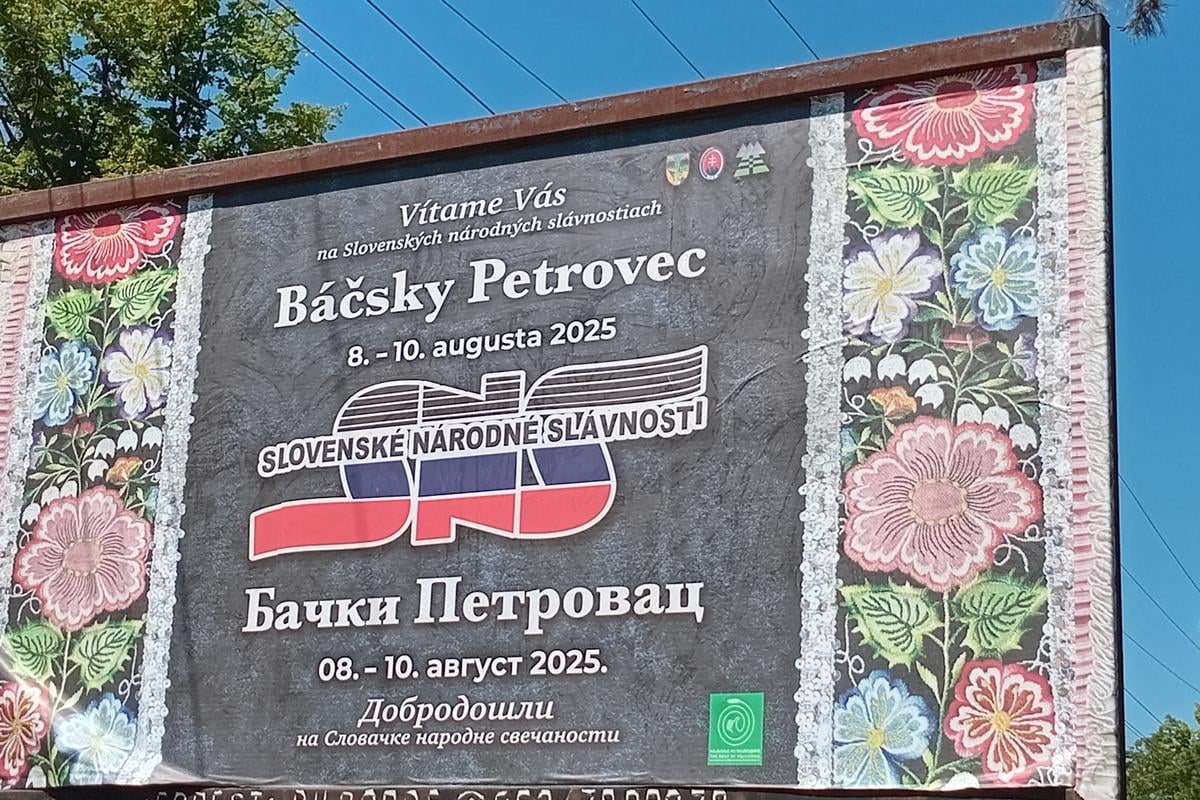 Community life and traditions of Vojvodina’s Slovaks were the central theme of the Slovak National Festivities, held in Bački Petrovac near Novi Sad, Serbia, from 8 to 10 August 2025. Yet the festival made headlines mainly because of a Saturday attack by government supporters on a photo exhibition about protests in Serbia, which was not part of the official programme. Several photographs were damaged in the assault and a number of people were injured. (source: TASR - Miroslav Gašpar)
Community life and traditions of Vojvodina’s Slovaks were the central theme of the Slovak National Festivities, held in Bački Petrovac near Novi Sad, Serbia, from 8 to 10 August 2025. Yet the festival made headlines mainly because of a Saturday attack by government supporters on a photo exhibition about protests in Serbia, which was not part of the official programme. Several photographs were damaged in the assault and a number of people were injured. (source: TASR - Miroslav Gašpar)
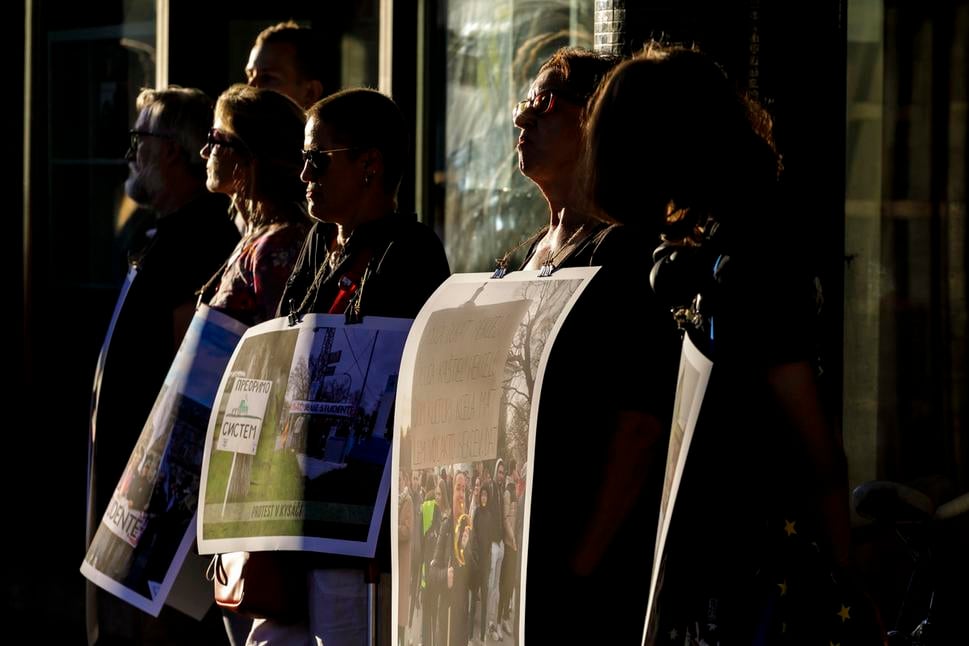 Protest event by the Open Culture! platform entitled Standing Together with Slovaks in Serbia – Photographs from Bački Petrovac Exhibited in Bratislava. The gathering took place in Bratislava on 19 August 2025. (source: TASR - Dano Veselský)
Protest event by the Open Culture! platform entitled Standing Together with Slovaks in Serbia – Photographs from Bački Petrovac Exhibited in Bratislava. The gathering took place in Bratislava on 19 August 2025. (source: TASR - Dano Veselský)
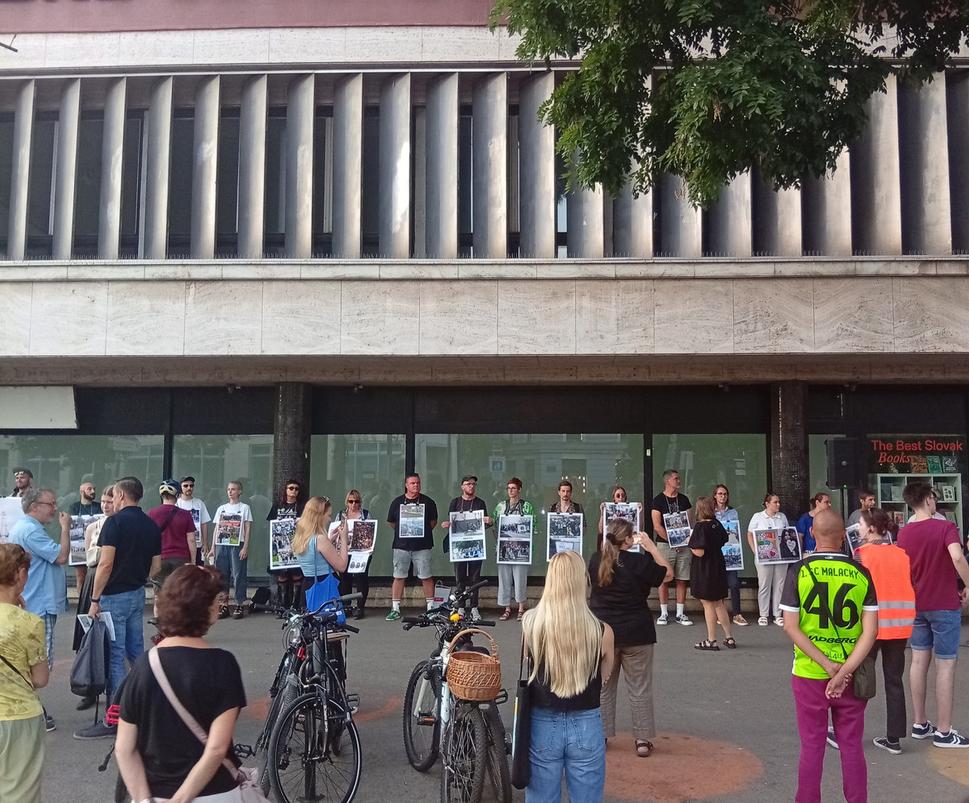 Protest gathering in support of student-led demonstrations in Serbia and of ethnic Slovaks in Vojvodina, held in Bratislava on 19 August 2025. (source: Peter Dlhopolec for The Slovak Spectator)
Protest gathering in support of student-led demonstrations in Serbia and of ethnic Slovaks in Vojvodina, held in Bratislava on 19 August 2025. (source: Peter Dlhopolec for The Slovak Spectator)
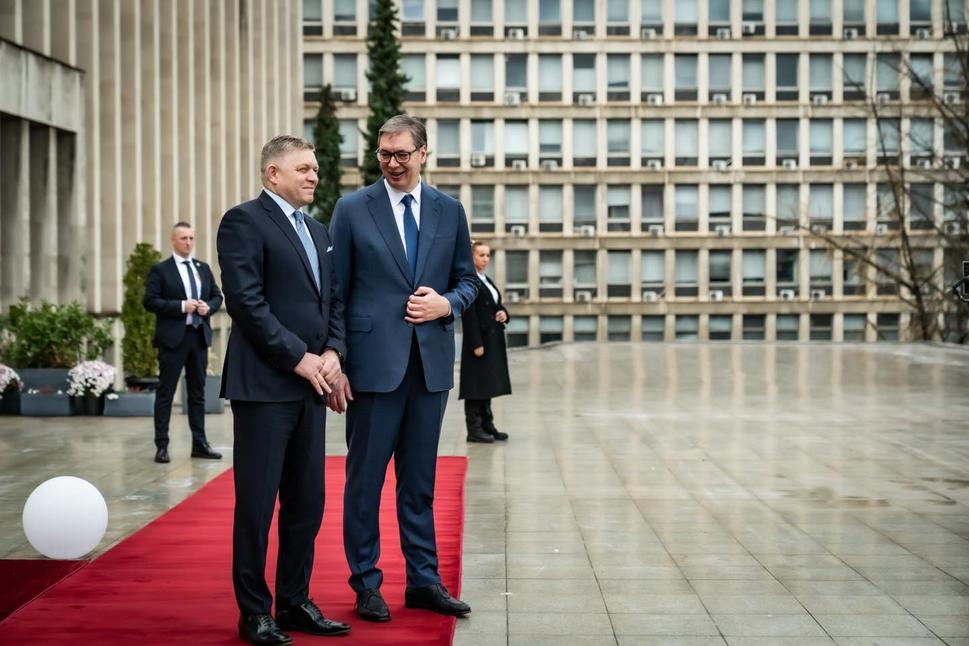 Slovak PM Robert Fico and Serbian President Aleksandar Vučić meet in Belgrade, Serbia, November 2024. (source: Facebook - Robert Fico)
Slovak PM Robert Fico and Serbian President Aleksandar Vučić meet in Belgrade, Serbia, November 2024. (source: Facebook - Robert Fico)
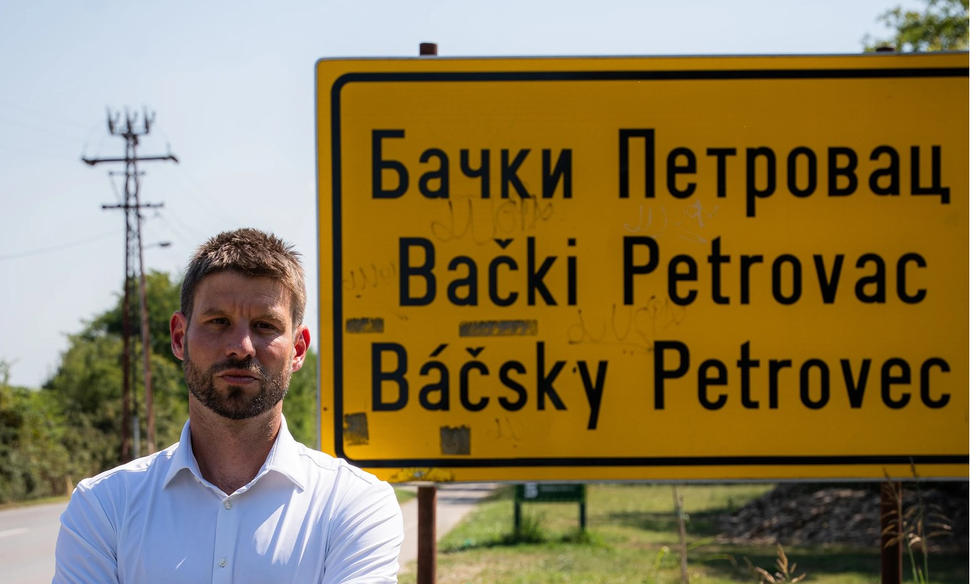 Progressive Slovakia leader Michal Šimečka in front of the welcome sign to Bački Petrovac, 13 August 2025. (source: Facebook - Michal Šimečka)
Progressive Slovakia leader Michal Šimečka in front of the welcome sign to Bački Petrovac, 13 August 2025. (source: Facebook - Michal Šimečka)